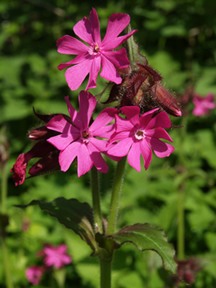UK: Making wildflowers count
19.04.10
As spring begins to take a firm hold on the British countryside the timing is perfect for the launch of Plantlife's Wildflowers Count - the successor to Common Plants Survey.
 There's something for everyone in this year's survey, so whether you're a complete amateur or seasoned recorder there are ways to get involved. The Common Plants Survey has been running successfully since 2000, using a list of 65 common plants. There's often such a pre-occupation with monitoring rarities that more common plants get left behind. This is a dangerous position and with such rapid changes in landscapes, could result in many plants being endangered without us even noticing.
There's something for everyone in this year's survey, so whether you're a complete amateur or seasoned recorder there are ways to get involved. The Common Plants Survey has been running successfully since 2000, using a list of 65 common plants. There's often such a pre-occupation with monitoring rarities that more common plants get left behind. This is a dangerous position and with such rapid changes in landscapes, could result in many plants being endangered without us even noticing.
Look out for one of the UK's favourite wildflowers, red campion (Silene dioica) on your survey.
© Andrew Gagg/Plantlife
“Wildflowers and other plants are the fundamental building blocks of our natural environment, sustaining us as well as the birds, mammals and other wildlife that we cherish,” says Sue Southway, Plantlife’s Wildflowers Count Survey Officer. “The wildflowers we see around us help show the health of our environment and factors such as improved farmland stewardship, changes in woodland management, pollution or climate change may all affect the wildflowers seen in positive or negative ways. When members of the public keep a watch and record what they see, particularly if they take part each year, their records help to show what is happening.”
Over the years volunteers who have taken part in the survey have given feedback and it's this that has led to Wildflowers Count.
There are three main ways to take part. All surveys are to be done within a 1km square near your home and this time there are up to 99 wildflowers to count:
Wildflowers Path - take a 1km walk through your square, taking note of any of the wildflowers from the guide along the way.
Wildflower Plots - the basis of the old survey. Plantlife will provide you with a survey plot.
Super-surveyor - for the more experienced there's now a chance to record as many species as possible.
All the information you need is on the Plantlife website. You can either use the contact form, email wfc@plantlife.org.uk, or telephone 01722 342755. There's also a series of events that you may want to take part in.
Related links:
15.04.10
 Records have started appearing at the National Trust's bluebell watch. First out of the blocks was Blickling Hall in Norfolk, closely followed by Downhill Demensne and Hezlett House in Northern Ireland.
Records have started appearing at the National Trust's bluebell watch. First out of the blocks was Blickling Hall in Norfolk, closely followed by Downhill Demensne and Hezlett House in Northern Ireland.
UK: Recovering from the winter blues
06.04.10
 The unusually harsh winter has taken its toll on many UK species while others seem blissfully unaware and are merely getting on with business as usual. But one plant which has almost certainly been stalled by the cold weather is the bluebell (Hyacinthoides non-scripta).
The unusually harsh winter has taken its toll on many UK species while others seem blissfully unaware and are merely getting on with business as usual. But one plant which has almost certainly been stalled by the cold weather is the bluebell (Hyacinthoides non-scripta).
UK: Ghost Orchid (slight return)
09.03.10
![]() News emerged yesterday that a Ghost Orchid (Epipogium aphyllum) was found in the UK in 2009 (link to Guardian story).
News emerged yesterday that a Ghost Orchid (Epipogium aphyllum) was found in the UK in 2009 (link to Guardian story).
09.02.10
 It's often said that we've all got a book inside us just waiting to be unleashed onto the world, but perhaps we should start with something smaller. Like a list.
It's often said that we've all got a book inside us just waiting to be unleashed onto the world, but perhaps we should start with something smaller. Like a list.
UK: Ecology, culture and passion
25.09.09
Richard Scott from Landlife tells us how they make things happen... Starting points are critical in determining the places you might get to. They are the launching platforms for what is possible. “Culture” said Liverpool poet Brian Patten “is a by-product of people’s aspirations; it’s to do with achievement, endeavour, hope, and all things that make us a little more than we begin as.”
UK: 2009 is a good vintage for Britain's rarest plants
01.09.09
The wild plant conservation charity, Plantlife, report that 2009 has been a great year for Britain's rarest plants.